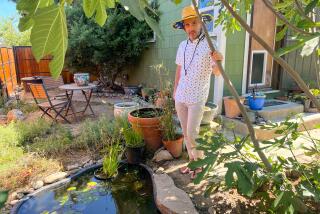NUTS & BOLTS : A How-To For Homeowners : ‘Silk’ Plants Taking Root as Realistic Alternative
- Share via
The Age of Aquarius turned me into a murderer.
While my increasingly mellow friends were turning their apartments into one-bedroom jungles, hanging aggressively blooming plants everywhere there wasn’t furniture (which was precisely everywhere), I was killing everything from Boston ferns to cacti.
I would buy plants guaranteed to survive a nuclear winter. After four days in my care, they turned to parchment. I watered them, fed them, played Mozart to them, threatened them. They all croaked. I had a cement thumb.
The solution was not plastic plants. In those days, an artificial fern looked less like a green plant than an opponent for Godzilla. Besides, you’d get the cold shoulder from the Earth Shoes crowd for being non-natural.
But today, people like me have to look at the bigger issue, which is whether to enjoy the permanent beauty of the fake stuff and risk being unhip, or to enjoy the brief beauty of real house plants before you suffer the guilt pangs of knowing that you hastened their cruel deaths through sheer botanical incompetence.
Fortunately, with today’s ersatz house plants, you can avoid a good bit of the indecision simply because they look so great. In some cases, in fact, they almost look more real than the real thing.
And they almost make Cindy Boothe look like a gardener. Boothe doesn’t deal in fertilizer or water or potting soil or sunlight or shade. She doesn’t tend plants, she assembles them.
Boothe is the owner of A Silk Thumb, a small shop in Santa Ana dedicated to silk plants and flowers. In her shop and others like it around the county, the silk plants and flowers are all but undetectable as facsimiles from, say, four feet away.
Are alarms going off? Are your natural budgetary defenses kicking in as you start recalling how much you paid for that silk blouse or raw silk sport coat? Relax. Silk in this case is mostly a generic term. Most “silk” plants and flowers are actually made from polyester or cotton blends, Boothe says.
The growing popularity of silk plants, she says, has as much to do with the low maintenance associated with them as with their realistic appearance. You simply plunk them down on, say, a high shelf--or in a windowless room where real plants would die or on top of a piece of furniture that might suffer water damage from an actual fern--and forget them for a few weeks. And there they stay, in perpetual full bloom.
When you think it’s time to do a bit of dusting, you find a dry paintbrush, gather up a handful of cloth leaves, and simply brush them off. If you have a large artificial plant such as a ficus, you can take it out on the patio and literally hose it down.
Most of the materials Boothe uses--about 90%, she says--come from the Orient. There are some U.S. companies that produce silk plants, but these are more expensive than their Asian counterparts. Some plants are made in Europe, but these too tend to be costly. A single flower from Holland, for example, may cost as much as $40, Boothe said.
Generally, though, the stuff isn’t cheap anywhere. One of Boothe’s large floral arrangements is priced at $85, a good-size ficus goes for $180 and a fairly full-looking philodendron runs about $50.
The main determinant of price, Boothe said, is how realistic the plant looks--and therein lies a caveat emptor.
“There’s a huge fluctuation in prices,” Boothe said, “because in this business the same word doesn’t necessarily mean the same thing.”
For example, she said, a silk ficus that goes for $40 at the local discount store may look as if it had suffered through a hard winter, and it may have a trunk that can quickly be spotted as fake. But a silk ficus on the market elsewhere for $150, with a real (albeit dead) trunk is going to look like a ficus, even up close.
To achieve that lifelike quality, manufacturers use a process in which the cloth is printed in much the same way a T-shirt would be silk-screened. Leaves or flowers with variegated colors require multiple pressings, and different fabric blends and coatings are used to achieve various textures and finishes.
In addition, Boothe said, some manufacturers are now using a process that involves imprinting an actual photographic image of a real leaf onto a cloth one.
Unlike a real plant, a silk one can be made to your specifications. Want it to look bushier? Boothe will drill a few more holes in the trunk and attach more branches and leaves.
Yes, custom orders or no, real plants are cheaper. But you have to leave them with the neighbors when you go on vacation, you have to water them and fuss over them and--heaven help us-- talk to them. If you’re lucky, they’ll live and you’ll get to feel like Luther Burbank.
But listen up, all you murderers, and remember this: You can’t kill a polyester fern. That ought to cheer you up if you have a bothersome conscience.
Besides, think of the fun you’ll have watching the cat try to decide whether to eat it.






